If you have recently received or purchased a pair of diamond earrings, you may be wondering whether the stones are real diamonds, other white gemstones, or artificial replicas. In short, you are eager to learn how to distinguish between real and fake diamonds.
Nowadays, there are several synthetic diamond alternatives that closely resemble genuine diamonds. Natural stones such as white topaz, white sapphire, and white zircon can easily be mistaken for diamonds due to their similarities.
If you have diamond earrings and are uncertain about their authenticity, it is advisable to seek guidance from a reputable jeweler. However, if you are pressed for time and wish to perform some initial tests at home, here are a few simple methods to help you determine if your diamond earrings are genuine or fake.
Without further delay, let’s explore these tests and find out the truth about your diamond earrings!
DESIGN YOUR OWN ENGAGEMENT RING: START WITH A SETTING OR START WITH A DIAMOND. IT’S REALLY UP TO YOU!
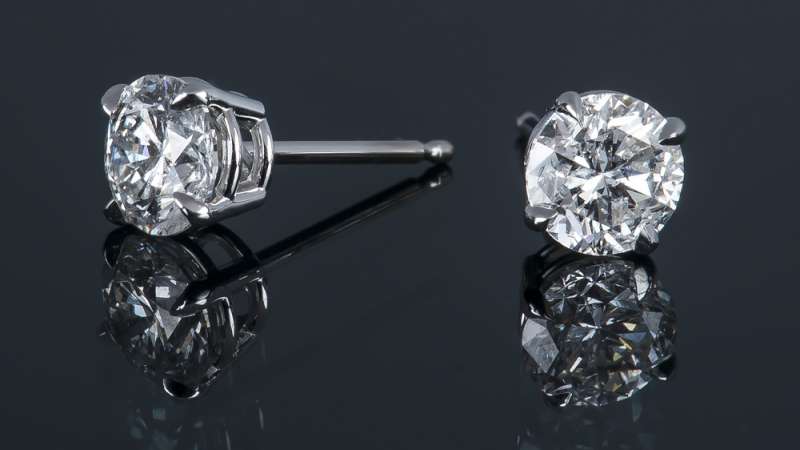
The Distinction Between Mounted and Unmounted Diamonds
When shopping for diamonds, it is important to be aware of the various diamond alternatives available in the market, as some may hold genuine value while others may not. This distinction is crucial to keep in mind during your diamond selection process. Additionally, understanding the difference between mounted and unmounted diamonds is essential.
An unmounted diamond, which refers to a loose diamond that has not been placed in a setting, offers easier evaluation in terms of authenticity and imperfections. When a diamond is mounted, any flaws or chips may be concealed, and the setting can affect how light interacts with the stone, making it more challenging for anyone other than an experienced jeweler to accurately assess the diamond’s color and clarity.
If you have the intention of purchasing a mounted diamond, it is advisable to request the jeweler to remove it from the setting so that you can examine it in its loose form. This allows for a more accurate assessment of the diamond’s characteristics.

Diamonds Vs. Faux Diamonds
There are several white gemstones that can resemble diamonds in appearance, but they are not genuine diamonds. These diamond simulants include cubic zirconia, white zircon, white topaz, white sapphire, moissanite, white spinel, quartz (rock crystal), and glass. These substances have distinct physical, chemical, and visual properties that differentiate them from genuine diamonds.
The most reliable way to determine if a diamond is real or fake is to have it tested by a jeweler using specialized equipment that measures thermal and electrical conductivity. However, this testing process can be expensive and requires professional expertise. It is worth noting that lab-created diamonds possess the same qualities as natural diamonds and can pass these tests. Therefore, if you suspect a diamond may be lab-created, the only way to confirm it is to have it examined by a gemological laboratory.
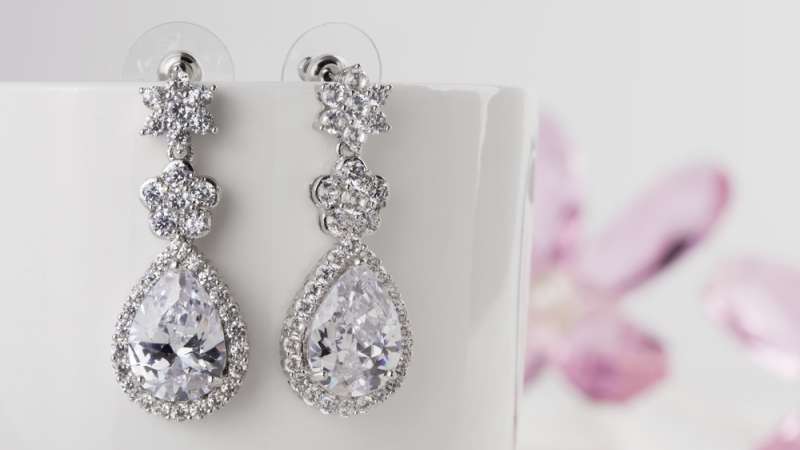
Tips When Shopping For Diamond Jewelry
Please keep in mind that not all of these tests can be conducted while purchasing a diamond. Instead, it is important to ensure that you buy from a reputable seller with a fair return policy.
If the diamond does not come with a gem laboratory-grade report, you can ask the seller if they would be willing to have it evaluated by a reputable laboratory on your behalf. This should not be an issue if the diamonds are genuine and the seller is trustworthy.
Diamond Certificate
A diamond certificate is a detailed document that provides information about various characteristics of the diamond, including color grade, carat weight, cut grade, and clarity grade.
Therefore, it is not advisable to purchase a diamond without a diamond certificate or a jeweler’s authentication certificate that verifies the value of the diamond.
The most reliable sources for determining the authenticity of a diamond are grading authorities such as the GIA (Gemological Institute of America), IGI (International Gemological Institute), AGS (American Gem Society), or an independent appraiser affiliated with a professional organization.
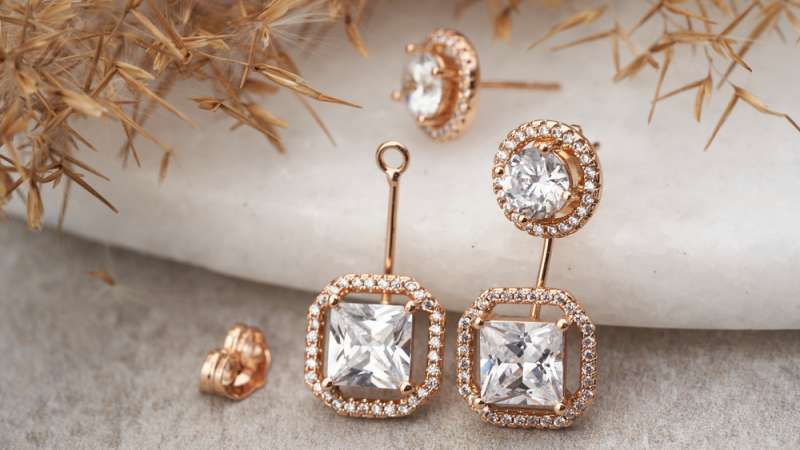
Ways To Determine If Your Diamond Earrings Are Real Or Fake
A gentle reminder: Not all of these tests can be conducted during the diamond purchasing process. Therefore, it is important to ensure that you buy from a reputable vendor with a reliable return policy.
- The Fog Test
To perform this test, hold the diamond in front of your mouth and breathe on it. A genuine diamond will quickly clear up, while a fake diamond will remain foggy for longer than three seconds. It’s worth noting that this test is not foolproof, as environmental factors can influence the results.
- Thermal Test
Using a diamond tester, which can be purchased online, you can assess the thermal conductivity of the stone. Only diamonds and moissanite will register on a diamond tester. If the stone is older and passes this test, it is likely a diamond.
- Water Test
Fill a glass with water and carefully drop the diamond into it. A genuine diamond will sink to the bottom due to its high density, while a fake diamond will float on the surface. However, not all imitation diamonds will float, so it’s best to combine this test with others.
- Magnifying Glass Test
Examine the diamond under a magnifying glass or loupe for any flaws or inclusions. Genuine diamonds often have microscopic imperfections, whereas fakes may appear flawless. Keep in mind that flawless natural diamonds are rare and expensive, while lab-created diamonds can also be flawless.
- UV Light Test
Place the diamond under a UV light source and observe its reaction. Most diamonds will exhibit a blue fluorescence under UV light. If the diamond shows a faint green, gray, or yellow fluorescence, it is likely not a genuine diamond. However, this test is not definitive, and professional evaluation is recommended.
- Loupe Test
Using a jeweler’s loupe, closely examine the diamond for any inclusions or imperfections. Natural diamonds have unique characteristics that cannot be replicated in synthetic diamonds. Loupes can be purchased online at affordable prices.
- Check The Mount
Inspect the type of setting used for the diamond. Genuine diamonds are typically set in platinum, white gold, yellow gold, pave or halo settings, or side-stone settings. Look for appropriate markings on the setting to ensure its authenticity.
- Scratch Test
The scratch test, which involves scratching the stone against a mirror, is not a reliable method for testing diamond hardness. Many imitations, such as moissanite and cubic zirconia, are also scratch-resistant. It is best to avoid this test to prevent damage to the stone.
- Check Transparency
Place the diamond on a piece of newspaper with small lettering and observe its refractivity. If you can read the letters through the diamond, it is likely fake. Genuine diamonds refract light in various directions, making the letters difficult to read.
- Fire Test
While not recommended due to potential hazards, some people believe that exposing a diamond to fire and then submerging it in cold water can determine its authenticity. A genuine diamond will not be affected by the heat, while a fake diamond may shatter. Proceed with caution if attempting this test.
- Use A Diamond Scale
Compare the weight of the diamond in question to that of a known genuine diamond of the same cut and carat weight. Cubic zirconia, for example, weighs around 55% more than a diamond. This test requires access to a diamond scale.
- Sparkle Test
Observe the diamond under a light source and assess its brilliance and ability to reflect light. Genuine diamonds exhibit exceptional brilliance and can reflect white light as well as fire or colored light. Cubic zirconia, on the other hand, may display a distinct rainbow of light.
Please note that these tests are not definitive and should be used as a preliminary assessment.
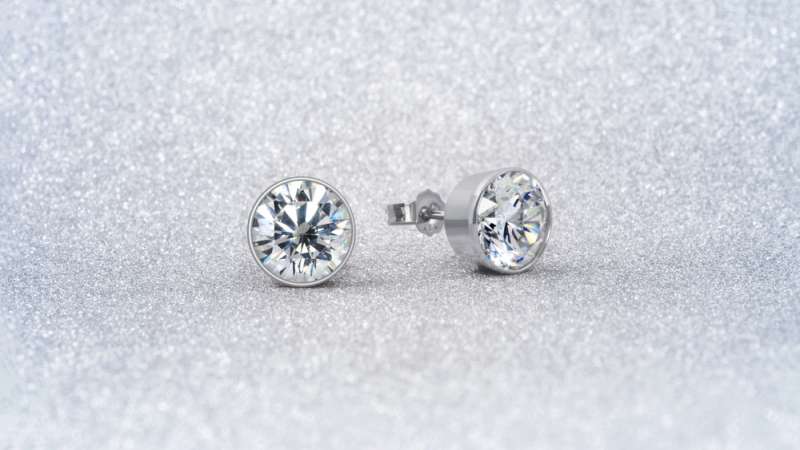
What Other Techniques Can Be Used To Determine The Diamond’s Authenticity
Electrical Conductivity Test
To determine if a diamond is genuine, an electrical conductivity test conducted by a jeweler or gemologist can be helpful. Diamonds, especially synthetic moissanite, have superior electrical conductivity compared to other gemstones.
Using an electrical tester, the conductivity of the stone can be measured, revealing whether it is a genuine diamond or a lab-created one. Most other stones, such as moissanite and cubic zirconia, do not exhibit conductivity.
X-Ray Test
For a comprehensive analysis of a gemstone’s internal molecular properties, it is recommended to send it to a reputable diamond laboratory.
The X-ray examination can differentiate between a radiolucent molecular structure found in diamonds and a radiopaque structure found in imitations like cubic zirconia and crystals. This test can provide valuable insights into the authenticity of the stone.
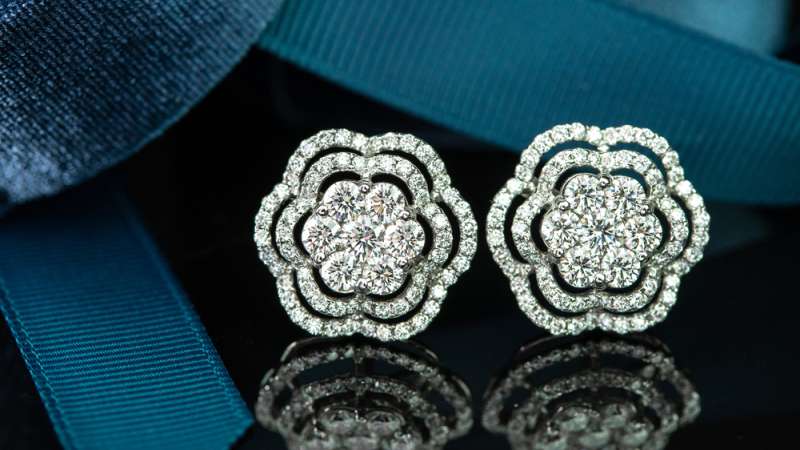
Final Words
Determining the authenticity of diamonds can be a complex process, and it is advisable to combine multiple tests to ensure accuracy. If you still have doubts, it is recommended to seek the expertise of a jeweler or specialist who has the necessary training to differentiate between genuine and fake diamonds.
Furthermore, when purchasing diamonds, you can rely on the authenticity certificates provided by reputable organizations such as AGS or GIA. Double-checking that the stone matches the certificate can provide additional assurance. Additionally, obtaining a grading report can further alleviate any concerns.
By following these steps, you can confidently determine whether your diamond earrings are real or fake.


